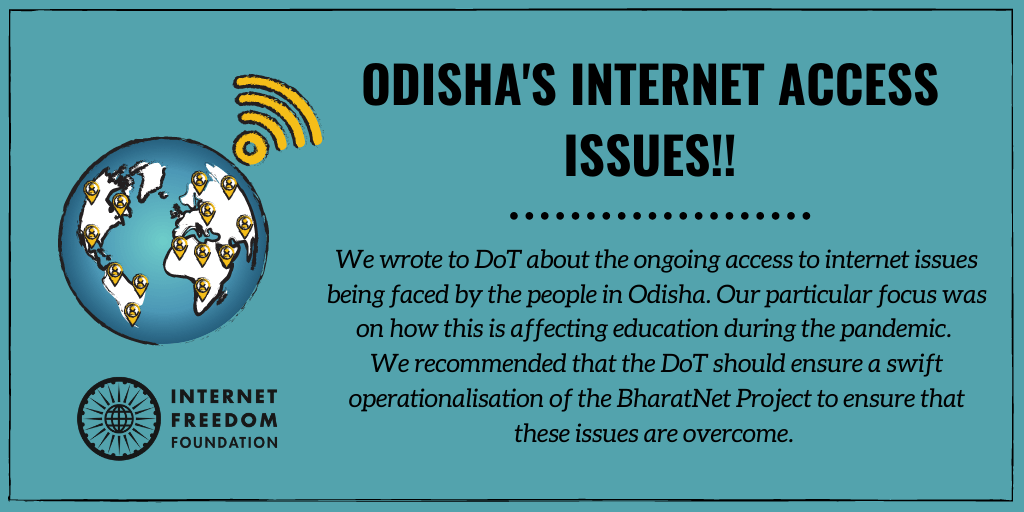
tl;dr
We wrote to the Department of Telecommunications (DoT) to highlight how lack of access to reliable and fast 4G internet is affecting the people of Odisha. We specifically highlighted how this is affecting students in the state who now have to take extreme measures to access online classes during the pandemic. We asked them to ensure that the BharatNet Project, which aims to provide fast internet connectivity to the whole country, is operationalised according to pre-existing timelines so that these issues can be resolved.
Let’s talk about Odisha
The State of Odisha has long been failing to keep up with the national average when it comes to internet connectivity. According to a report by Diana Sahu, “tele-density in rural Odisha is 42.7 pc whereas in urban areas it was 171 pc.” She also referred to the Indian Telecom Services Performance Indicators reports by the Telecom Regulatory Authority of India, which state that, as on September 30, 2019, Odisha’s rural wireless tele-density stood at 59.5 pc against 145.3 pc in urban areas.
Out of Odisha’s total 32.8 million wireless internet subscribers, 21 million are in rural areas. As far as the internet through wireline or cable is concerned, of the total 0.23 million subscribers in Odisha, only 0.05 million are from rural areas. Rural Odisha’s wireline density is just 0.13 pc. Sahu concludes that “the share of internet subscribers per 100 individuals is just 29.5 pc in rural areas which is substantially below the national average.”
What is the situation now?
The COVID-19 pandemic has forced people to be dependent on the internet for access to basic necessities like government services and schemes, online education etc. In the present situation, lack of internet connectivity can cause extreme harms to any such affected area. We have been working consistently on the issues surrounding lack of internet connectivity in -
- Andaman & Nicobar Islands which suffers from a lack of digital infrastructure; and
- Jammu & Kashmir which has been tolerating internet shutdowns for more than a year now.
In both these areas, we have focused our advocacy efforts on how a lack of internet connectivity affects the daily lives and livelihoods of ordinary citizens. In Odisha as well, we have been following how the lack of digital infrastructure is affecting its citizens.
The COVID-19 pandemic has aggravated structural disparities between rural and urban areas. It has had a critical impact on the education of children, especially the disadvantaged ones. Subhashish Mohanty reports that students in the Sambalpur district of Odisha climb a water tank 150 feet high to access the internet to participate in their online classes. Another report quoted the Odisha School and Mass Education Minister Samir Ranjan Dash who said that “due to poor internet connectivity in the state many students have to walk miles, climb hills and trees to attend online classes during the COVID-19 pandemic.”
The BharatNet Project
The BharatNet project, which initially began as the National Optical Fibre Network on October 25, 2011, had a targeted completion date of October 2013. The Cabinet has approved the implementation of National Optical Fiber Network (NOFN) for providing broadband connectivity to 2,50,000 Gram Panchayats with a financial outlay of Rs. 20,100 crore. This project is being executed by Bharat Broadband Network Limited (BBNL) under the Universal Service Obligation Fund (USOF), Department of Telecommunications(DoT). The USOF aims to provide Universal Service to all areas of the country through network extension & stimulate uptake of the information and communications technology services. Section 3(1A) of Telegraph Act, 1885 defines Universal Service Obligation as :
“Universal Service Obligation" means the obligation to provide access to telegraph services to people in the rural and remote areas at affordable and reasonable prices;
However, while the project has lofty aims, it has not been able to live up to them. The project has been delayed consistently. The Committee to review the National Optical Fibre Network (NOFN) in the context of Digital India was constituted on January 14, 2015. In their report titled “Report of the Committee on National Optical Fibre Network (NOFN)” dated March 31, 2015, they stated that the project could be commissioned by 2017 however those deadlines were also not met. The current deadline for the project is August 2021.
According to a report by Aashish Aryan, “Overall, under all the phases of BharatNet, a total of 1.41 GP had been connected and made service ready as against a target of 2.5 lakh. Compounding the problem further, an estimated 19,952 km of lossy optical fibre out of the 27,534 km laid by Bharat Sanchar Nigam Limited (BSNL) under phase one is now being pulled out and replaced by new optical fibre, the official said, adding the work on that project was also “crawling at a very slow pace”. As of January, progress in states like Andhra Pradesh, Jharkhand, Maharashtra, and Odisha under BharatNet phase two was the worst. The number of service-ready GPs in these states had not even touched 1 per cent of the total 28,623 villages planned to be connected by March 2019. The four states had so far spent about Rs 950 crore, nearly 17 percent of approved project cost.”
Access to Internet is essential
In Anuradha Bhasin v. Union of India [2020 SCC OnLine SC 25], it was held that the internet is a medium to exercise fundamental rights provided by the Constitution of India. The judgement states that expressing one’s views or conducting one’s business through the internet are protected under Articles 19(1)(a) and 19(1)(g) of the Constitution respectively. However, does the Government have a positive obligation to provide access to the internet?
The National Digital Communications Policy (NDCP), 2018 seeks to unlock the transformative power of digital communications networks - to achieve the goal of digital empowerment and improved well-being of the people of India. To this end the NDCP attempts to outline a set of goals, initiatives, strategies and intended policy outcomes. This policy has three missions, the first of which is “Connect India: Creating Robust Digital Communications Infrastructure”. The aim of this mission is to promote Broadband for All as a tool for socio-economic development, while ensuring service quality and environmental sustainability.
Our recommendations to the DoT
As can be seen, while the delay in the operationalisation of the BharatNet Project in Odisha has been overlooked in the past, the current situation makes access to the internet essential. Therefore, we wrote to the Department of Telecommunications (DoT) with a list of recommendations specifically for Odisha:
- The USOF division of the DoT must implement the BharatNet project according to pre-existing timelines, and if they are not able to do so they must make public the reasons for this. They should also then provide clear timelines in which they estimate the work will be completed which should include a monthly breakdown of work completed. They should also announce an explicit last date by when the project is complete and a detailed timeline with expected benchmarks.
- BBNL must highlight if they face any regulatory hurdles, so that those can be worked on by the DoT and the USOF division, BBNL and local municipal authorities.
- In the interim, vulnerable populations should be provided with subsidised broad based internet based services/transaction opportunities at CSCs, kiosks, post offices, legal services authorities, cyber cafes, etc.
- Funds should also be allocated under USOF and national/state disaster relief funds for subsidised access to internet connectivity and internet enabled devices. Special subsidies can be designed for students, healthcare workers and senior citizens.
Help us map the Digital Divide in India
In a reply to a question in Lok Sabha, Sanjay Dhotre, MoS for Communications, Human Resource Development and Electronics & Information Technology said that, “In 27,721 villages of India, there are still no mobile connections due to various issues”. Odisha trails the most with 6,549 villages without any mobile network. Maharashtra, Madhya Pradesh, Chhattisgarh, and Andhra Pradesh follow Odisha with 2000-3000 villages without any mobile network. This sets back our fellow Indians, from the benefit of fast and affordable 4G internet.
If you live in such a region that lacks mobile internet infrastructure and want to help us in mapping this digital divide, please fill out the form below. We will assess the reason for the lack of 4G infrastructure and seek appropriate interventions. Help us help you!

